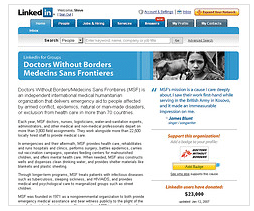
PR Blogger Stephen Davies thinks we’ll start to see a fragmentation of social networks. As people begin to tire with the vast, general nature of MySpace et al, they may migrate to niche social networks that are more relevant to them, their passions and their lives.
He asks:
So what does it mean for brands? Niche social networks can be tapped into for more relevancy in online engagement. For example, which platform makes the most sense for a brand like Pedigree? Bebo or DoggySnaps?
Stephen continues…
But identifying the right platform is just the minor part. It’s how you engage with the users in a creative, respectful and non-intrusive manner which will be the key to a successful online PR campaign…
Spot on, Stephen. I’ll come back to that.
Interestingly, there is already some activity in the ’social networks for change’ space. Change.org launched last month, and Cauzoo.com will be “a space where you can promote your passion, rally for a cause, and raise money for charities in a variety of different ways.”
 And then there’s Carebadges… who do it with widgets.
And then there’s Carebadges… who do it with widgets.
It’s early days, but I’m not totally convinced that these social networks are themselves authentic enough: they seem a little forced… activism for activism’s sake (not that there’s anything wrong with that particularly). I’m not sure about the lack of focus though – well, unless you’re an activist first, and something else second.
You need to get close to where your supporters are (and their distributed network)… which is why DoggySnaps is so good.
Moving on… I’ve harped on before about how I registered the mycauses.org.uk domain and how I hoped one of the players in the social networking space would create a “My Causes” tab in their members’ profile pages.
 Well, I’m pleased to see that LinkedIn has moved a step in this direction, and should be applauded – thanks to Kerri Karvetski for the tip-off.
Well, I’m pleased to see that LinkedIn has moved a step in this direction, and should be applauded – thanks to Kerri Karvetski for the tip-off.
LinkedIn for Good
The first not-for-profit to benefit from a presence on LinkedIn is Médecins Sans Frontières.
It looks pretty good… up to a point! I feel it’s only a start though, as this still has the feel of what you might call a “networked giving” and nothing more – in other words, too much focus on fundraising.
The implementation on a member’s profile page (see below) could be improved. I’m not sure that “Member” is entirely accurate in this context either.

What if I want a different kind of relationship with a not-for-profit… or with a cause with which I identify for some reason?
LinkedIn members are – on the whole – accustomed to having more of a voice. In fact, I believe that LinkedIn will discover that members will desire a 360 degree relationship with not-for-profits.
LinkedIn feels entrepreneurial. There’s real potential here I think for the not-for-profits to engage members of the LinkedIn network in a relationship that goes beyond giving. Think of members of LinkedIn as potential ambassadors for your cause.
I might be able to indicate in my profile that a preference for becoming a virtual volunteer and trustee.
As Jeff Brooks writes, donors can also give:
- Information: ranging from market insight to specialized professional knowledge.
- Voice: the ability to speak for you in many ways.
- Influence: the ability to help things go your way.
And of course, donations will surely follow.
The 9m+ members of LinkedIn must carry a fair bit of clout between them. You’d think it would be pretty unstoppable if this collective intelligence – already into thinking about network-building and showing leadership in a networked world – could be harnessed to support individual actions through the social network, even to find solutions to problems.
I can actually foresee new agile social enterprises springing up from a network like LinkedIn… united by their ability to connect to others with shared passions, complementary skills, and a vision to change things. And I’m sure there’s a link here with the creation of like the Omidyar Network and Kiva.
 There, I’ve just this minute received an email from LinkedIn’s Dave Sanford (thanks for getting back to me, Dave), so this post should serve as a good discussion opener!
There, I’ve just this minute received an email from LinkedIn’s Dave Sanford (thanks for getting back to me, Dave), so this post should serve as a good discussion opener!
Returning to the DoggySnaps example… what started as a photo-sharing community has the potential to evolve into a dynamic social network.
Niche, yes… but it can extend the reach of the Dogs Trust, the not-for-profit behind it.
(Related post: my DoggySnaps interview).
